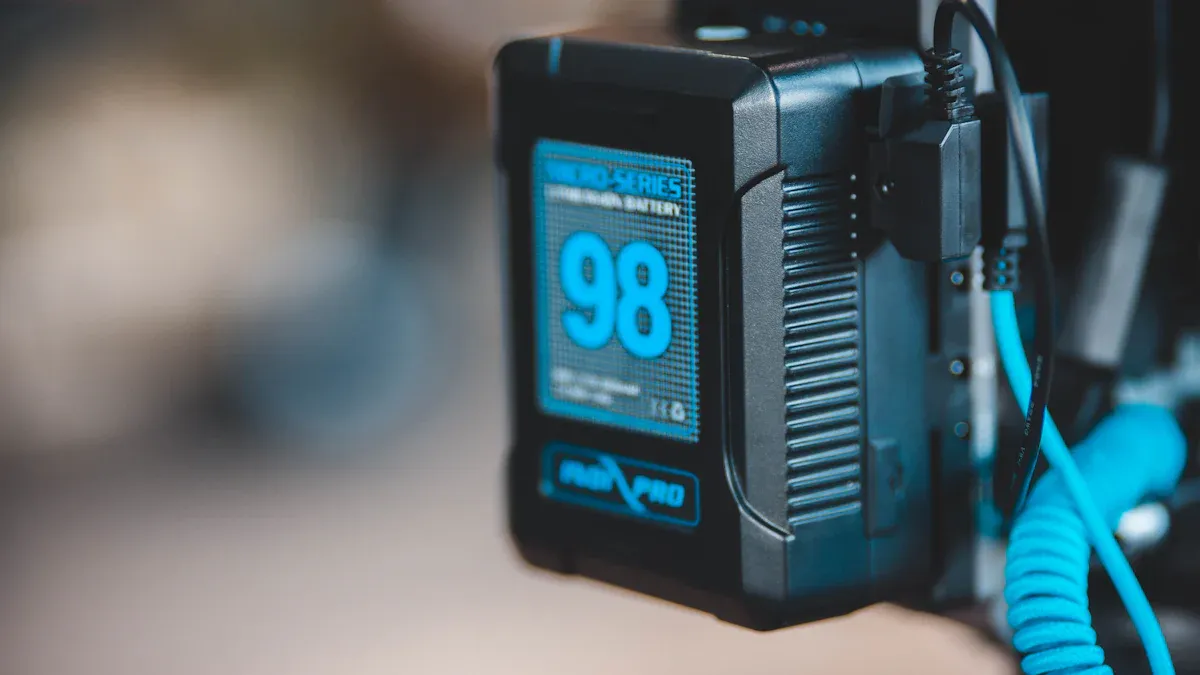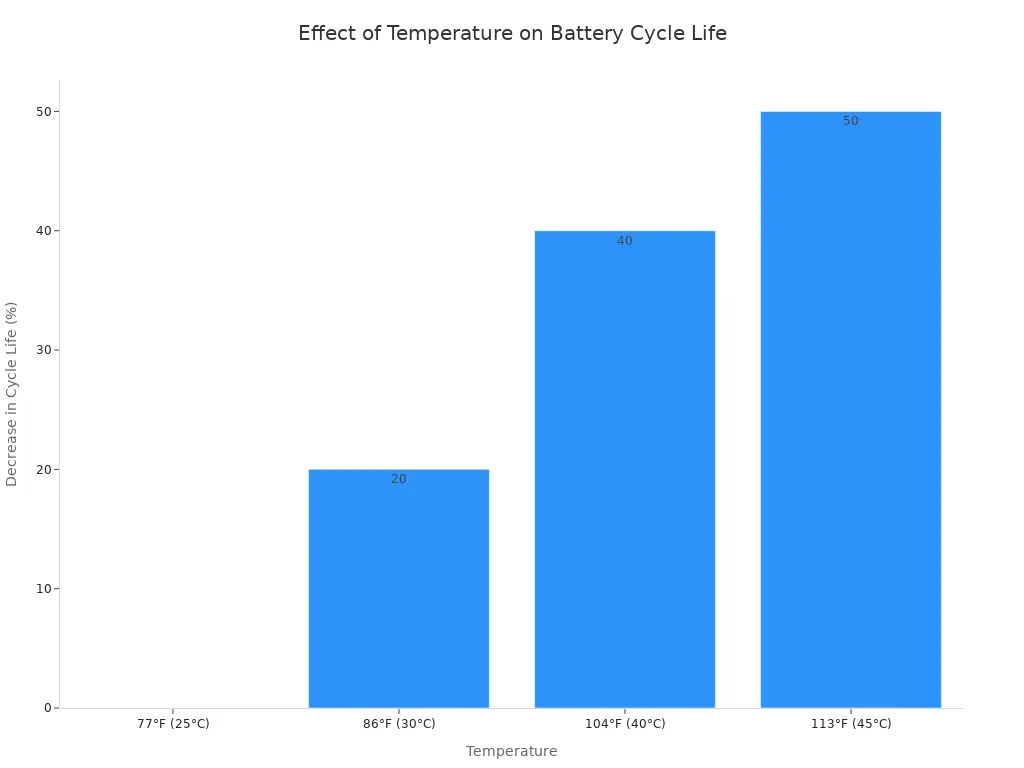
The best battery for your wireless speakers is a lithium ion battery or a lithium polymer battery. These power sources provide more playtime in a lighter package for all kinds of bluetooth speakers. They offer a long lifespan and superior value.
In fact, this battery technology led the consumer electronics market in 2023, capturing over 31% of the revenue share.
This dominance makes it the clear choice. You get the top speaker battery for modern bluetooth speakers, ensuring powerful and reliable performance.
Why Lithium-ion Dominates for Wireless Speakers

You see lithium-ion batteries in nearly every modern portable device, from phones to laptops. This is no accident. Their chemistry gives them several key advantages that make them the perfect power source for high-performance bluetooth speakers. Let’s break down why a lithium ion battery is the undisputed champion.
Superior Energy Density
Energy density measures how much power a battery can store for its size and weight. A higher energy density means you get longer playtime from a lighter, smaller battery. This is crucial for portable wireless speakers, where you want maximum power without the extra bulk.
Lithium-ion batteries pack a serious punch. They typically offer an energy density between 150 and 250 watt-hours per kilogram (Wh/kg). This high capacity allows manufacturers to design sleek, powerful speakers that can play music for hours. A lithium ion battery can hold at least twice the energy of an older Nickel-Cadmium (NiCd) battery of the same size.
A Quick Comparison ⚖️
This table shows how much more energy a lithium ion battery holds compared to older rechargeable battery types.
Akku-Typ Energy Density (Relative to NiCd) Lithium-Ionen 2x to 3x more energy NiMH 1.4x to 1.6x more energy NiCd Baseline (1x)
This superior capacity directly translates to better performance and a more enjoyable listening experience with your bluetooth speakers.
Excellent Lifespan and Recharge Cycles
You want a speaker battery that lasts. The lifespan of a battery is measured in two ways: its total operational years and the number of charge cycles it can handle before its performance degrades. Lithium-ion batteries excel in both areas, offering great durability.
A typical lithium ion battery will last you 2 to 3 years with normal use. In contrast, older rechargeable NiMH batteries often last only 1 to 2 years. This longer lifespan means you spend less time and money on replacements. Furthermore, these batteries can endure hundreds of full charge and discharge cycles while retaining most of their original capacity, ensuring consistent performance over the life of your speaker.
Low Self-Discharge Rate
Have you ever charged a device, left it on a shelf for a few weeks, and returned to find the battery dead? This is called self-discharge. It’s the natural, slow loss of charge that happens even when a battery is not in use.
This is another area where lithium-ion technology shines.
- Lithium-Ionen-Batterien lose only 1-3% of their charge per month.
- Older NiMH batteries can lose 15-30% of their charge in the same period.
This extremely low self-discharge rate means your speaker is ready to go when you are. You can charge your device and trust that the battery will still hold most of its power weeks later, making it a reliable choice for your wireless speakers.
No “Memory Effect”
The “memory effect” is a frustrating issue found in older rechargeable battery technologies like NiCd. If you repeatedly recharged a NiCd battery after only partially using it, the battery would “remember” that smaller capacity. It would then only provide that reduced amount of energy, effectively shrinking its own battery life.
What is the “Memory Effect”? 🤔
This phenomenon occurs when crystals form on the battery’s internal plates, preventing it from reaching a full charge. The battery essentially forgets its true full capacity.
Thankfully, you do not have to worry about this with modern bluetooth speakers. The chemistry of lithium-ion batteries prevents this crystal formation. You can charge your speaker for 10 minutes or two hours, from 50% or 10%, without damaging the battery’s long-term capacity or durability. This flexibility makes maintaining your speaker battery simple and worry-free, ensuring top performance for years.
How Other Battery Types Compare
Lithium-ion is the clear winner, but you might see older technologies in some devices. Understanding their weaknesses shows you why modern bluetooth speakers moved on. These older battery types simply cannot keep up with today’s power demands.
Nickel-Metallhydrid (NiMH)
You may find Nickel-Metal Hydride (NiMH) batteries in some older electronics. While this rechargeable battery technology has improved, it cannot compete with lithium-ion. NiMH batteries have a lower energy density, meaning they are heavier for the same amount of power.
Their biggest drawback is a high self-discharge rate.
- A standard NiMH battery can lose 20-30% of its charge in a single month.
- You would need to recharge the battery frequently, even when not using your speaker.
This makes them an inconvenient choice for a device you want ready at a moment’s notice.
Nickel-Cadmium (NiCd)
Nickel-Cadmium (NiCd) is an outdated rechargeable battery technology for two major reasons: performance and safety. This type of battery suffers from a severe “memory effect.” If you repeatedly recharge it before it’s fully empty, the battery “forgets” its full capacity. This leads to shorter runtimes and unexpected shutdowns for your bluetooth speakers.
Environmental Hazard ☣️
NiCd batteries contain cadmium, a toxic heavy metal. Improper disposal allows cadmium to leak into soil and water, posing a significant risk to human health and the environment.
Alkaline (Disposable)
You know alkaline batteries as the standard disposable option. They are a poor choice for any powerful wireless speakers. Their biggest weakness is an inability to deliver high bursts of current. This is due to high internal resistance. Your speaker needs high current to produce deep, powerful bass, and an alkaline battery simply cannot provide it. The sound will often be weak or distorted.
Using them also creates a lot of waste and becomes very expensive over time. You would constantly be buying a new battery, making them a costly and unsustainable option.
Choosing the Right Speaker Battery
Finding the right replacement speaker battery ensures you get the best performance and safety. You need to match a few key specifications. Understanding these battery requirements will help you make a confident choice for your bluetooth speakers.
Understanding Capacity (mAh) for Longer Playtime
You measure battery capacity in milliampere-hours (mAh). A higher mAh number generally means a longer playtime. For example, a high capacity battery around 10,000mAh might give you over 20 hours of music. Smaller bluetooth speakers often use a battery with a capacity between 2,000mAh and 4,000mAh. However, the final playtime depends on your usage. Playing music at maximum volume will use the battery much faster. A higher capacity gives your speaker battery more fuel to work with.
Matching Voltage (V) and Physical Size
You must match the voltage (V) of your old battery. Using a battery with the wrong voltage can damage your speaker. The physical size is also important. The new rechargeable battery must fit perfectly inside your speaker’s battery compartment. Always check the original speaker battery or the device manual for the correct voltage and dimensions. These are the most important battery requirements.
Common Formats: The 18650 Battery
Many electronics use a standard type of lithium ion battery called the 18650. You might find an 18650 rechargeable lithium battery inside your speaker. This common format makes finding a replacement easier.
The 18650 Standard 📏
An 18650 rechargeable lithium battery typically has a nominal voltage of 3.6V to 3.7V. Its name comes from its size: around 18mm in diameter and 65mm in length.
Prioritizing Safety and Quality
Your safety is the top priority. Always choose a high-quality rechargeable battery from a reputable brand. Look for safety certifications on the packaging.
- UL (Underwriters Laboratories) certification means the battery passed strict safety tests.
- CE (Conformité Européene) marking shows the battery meets European safety standards.
Avoid cheap, unbranded batteries. Counterfeit batteries often lack internal safety features. This makes them a fire hazard. They can overheat, explode, and deliver poor performance. Investing in a quality battery guarantees safety and optimal performance for your device.
Tips for a Longer Battery Life

You can extend the lifespan of your speaker battery with a few simple habits. Proper charging practices and care will keep your device playing music for years. These tips help you get the most out of your battery.
The “Half-Full” Charging Rule
You might think keeping your battery at 100% is best. However, lithium-ion batteries are healthiest when partially charged. For long-term storage, you should keep the battery level between 40% and 50%. This simple step significantly slows down capacity loss over time. Constantly keeping the battery at full charge puts stress on its internal components. This stress reduces its overall lifespan. Following this rule is a key part of good battery care. This charging method helps preserve the battery.
Pro Tip 💡 Avoid leaving your speaker plugged in all the time. Unplug it once the charging is complete to protect the battery life. This prevents unnecessary stress on the battery.
Avoid Extreme Temperatures
Extreme heat and cold are enemies of your speaker battery. High temperatures permanently damage lithium-ion batteries. Leaving your speaker in a hot car can cause irreversible harm. Heat speeds up the chemical reactions inside the battery, which shortens its lifespan.
- At 86°F (30°C), a battery’s cycle life can decrease by 20%.
- At 104°F (40°C), that decrease jumps to 40%.

You should store your speaker in a cool, dry place, ideally between 59°F and 77°F. This simple habit will greatly extend your battery life.
When to Replace Your Battery
Every rechargeable battery eventually wears out. You will know it is time for a replacement when you notice these signs:
- The speaker does not hold a charge for very long.
- The device shuts down unexpectedly, even with battery remaining.
- The battery takes much longer than usual to complete its charging.
Fortunately, a replacement is often an affordable fix. A new speaker battery typically costs between $25 and $30. This small investment can make your speaker perform like new again.
For your wireless speakers, a lithium ion battery is the only practical choice. Lithium-ion batteries deliver the best performance and longest playtime for your bluetooth speakers. This battery offers superior value over any other type.
Final Tip 💡 When you need a new speaker battery, always choose a quality replacement battery. You must match the original speaker battery capacity and voltage. This ensures your battery provides safe, optimal performance and maintains its capacity.
FAQ
Can I use my speaker while it is charging?
Yes, you can use most modern bluetooth speakers while they charge. The internal circuitry manages power safely. This action will not harm your lithium-ion battery. Your music can keep playing without any issue.
Is it hard to replace a speaker battery?
The difficulty depends on your speaker’s design. Some models have an easy-to-access battery door. Others may require you to open the speaker’s main body. You should check your user manual or look for online guides for your specific model.
Will a higher mAh battery damage my speaker?
No, a higher mAh battery will not damage your speaker. The mAh rating only affects how long the battery lasts. A higher number simply gives you more playtime between charges.
Important: You must always match the voltage (V) of the original battery. The wrong voltage can permanently damage your speaker.
Why don’t speakers use AA batteries? 🔋
AA alkaline batteries cannot deliver the high current your speaker needs for powerful bass. The sound would be weak. Using disposable batteries also becomes very expensive and creates a lot of waste compared to a rechargeable lithium-ion battery.

